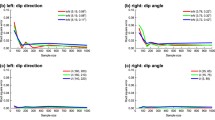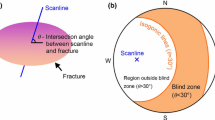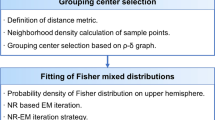Use of the scanline mapping technique in geometric surveys of rock discontinuities can often lead to a bias, in that discontinuities are not always observed when they are at small angles to the scanline. Terzaghi introduced the concept of a blind zone to explain this bias, and developed a widely used procedure to correct for it. Unfortunately, little is known about errors that may occur when the Terzaghi procedure is used outside the blind zone. This paper presents a detailed derivation to show that such errors arise with this application of the Terzaghi procedure. This error was evaluated using simulated orientation data and a case study of the 2008 Wenchuan earthquake (Sichuan, China). The results of these tests yield the optimal values of grid size and sample density for reducing the error.












Similar content being viewed by others
References
B. H. G. Brady and E. T. Brown, Rock Mechanics for Underground Mining, 3rd edn, Vol. 2, Springer, Dordrecht (2006), pp. 133–139.
E. Hoek, Practical Rock Engineering, 1st edn, Vol. 1, 6, Evert Hoek Consulting Engineer Inc., North Vancouver (2007).
N. Barton, “Shear strength criteria for rock, rock joints, rockfill and rock masses: Problems and some solutions,” J. Rock Mech. Geotech. Eng., 5, 249–261 (2013).
C. Xu and P. Dowd, “A new computer code for discrete fracture network modeling,” Comput. Geosci., 36, 292–301 (2010).
A. K. Manda and S. B. Mabee, “Comparison of three fracture sampling methods for layered rocks,” Int. J. Rock Mech. Mining Sci., 47, 218–226 (2010).
R. D. Terzaghi, “Source of error in joint surveys,” Geotechnique, 15, 287–304 (1965).
O. Fouché and J. Diebolt, “Describing the geometry of 3D fracture systems by correcting for linear sampling bias,” Math. Geol., 36, 33–63 (2004).
R. Goodman, “Toppling – a fundamental failure mode in discontinuous materials – description and analysis,” in: C. L. Meehan, D. Pradel, M. A. Pando, and J. F. Labuz (Eds.), Geo-Congress 2013: Stability and Performance of Slopes and Embankments III (Proc. of a meeting held 3–7 March 2013, San Diego, CA), Geotechnical Special Publication No. 231, in 3 volumes, American Society of Civil Engineers (2013), pp. 2338–2368.
H. J. Park and T. R. West, “Sampling bias of discontinuity orientation caused by linear sampling technique,” Eng. Geol., 66, 99–110 (2002).
S. D. Priest, Discontinuity Analysis for Rock Engineering, 1st edn, Vol. 2, 5, Springer, Hong Kong (1995).
Ö. Senger and A. K. Çelik, “A Monte Carlo simulation study for Kolmogorov–Smirnov two-sample test under the precondition of heterogeneity: upon the changes on the probabilities of statistical power and type I error rates with respect to skewness measure,” J. Statist. Econom. Meth., 2, No. 4, 1–16 (2013).
M. S. Ozçomak, M. Kartal, Ö. Senger, and A. K. Çelik, “Comparison of the powers of the Kolmogorov–Smirnov two-sample test and the Mann–Whitney test for different kurtosis and skewness coefficients using the Monte Carlo simulation method,” J. Statist. Econom. Meth., 2, No. 4, 81–98 (2013).
Acknowledgments
This research was supported by the National Natural Science Foundation of China (Grant Nos. 41230637, 41302231, and 41272309). The authors would like to thank our group for the orientation observations.
Author information
Authors and Affiliations
Corresponding author
Additional information
Translated from Problemy Prochnosti, No. 6, pp. 111 – 121, November – December, 2016.
Rights and permissions
About this article
Cite this article
Tang, H.M., Huang, L., Bobet, A. et al. Identification and Mitigation of Error in the Terzaghi Bias Correction for Inhomogeneous Material Discontinuities. Strength Mater 48, 825–833 (2016). https://doi.org/10.1007/s11223-017-9829-9
Received:
Published:
Issue Date:
DOI: https://doi.org/10.1007/s11223-017-9829-9




